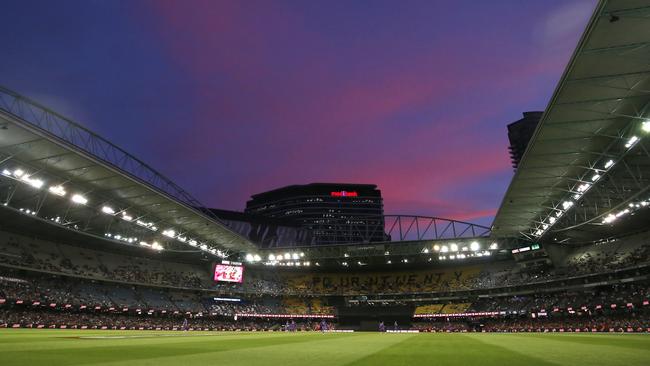Urgent works after flammable cladding found on Marvel Stadium
Victoria’s cladding crisis has hit one of Melbourne’s largest sporting venues, with urgent works prompted on Marvel Stadium after the flammable material was found at the sporting ground. But the AFL, which owns the venue, insists it’s safe for patrons.
VIC News
Don't miss out on the headlines from VIC News. Followed categories will be added to My News.
Flammable cladding has been discovered on Marvel Stadium.
The Sunday Herald Sun can reveal authorities found non-compliant combustible cladding on the exterior of the AFL-owned stadium late last year.
It prompted urgent works to ensure footy fans are not at risk if there is a fire.
The AFL maintains the stadium is safe for patrons, with fire safety measures including alarms and sprinklers closely monitored.
But a building industry source with knowledge of the cladding says it should be stripped from the stadium.
The Metropolitan Fire Brigade has “enhanced response plans” in place to send extra resources to the stadium if there is a fire during a major event.
The Sunday Herald Sun has also learned the surveyor which ticked off on the stadium approved other major projects where dodgy cladding has been found.

They include the Royal Women’s Hospital — now at the centre of a Supreme Court battle — and the Anstey Square apartments in Brunswick, which caught fire in 2017.
Marvel Stadium called in independent experts who ordered remedial works to some sections of cladding.
It has now been deemed low-risk, and it is understood parts of the cladding will likely be removed in a government-funded $225 million revamp of the ground.
Combustible cladding has previously been identified at AAMI Park and Geelong’s GMHBA Stadium, where the Kardinia Park Stadium Trust has promised “long term rectification works”.
A City of Melbourne spokeswoman confirmed the municipal building surveyor had “investigated combustible cladding on parts of Marvel Stadium” and was “working with the stadium to rectify the situation”.
AFL spokesman Jay Allen said the cladding, installed during construction, had been “extensively analysed as low risk”.
“The stadium will continue to work with the City of Melbourne to ensure the stadium delivers a safe and fun environment for the thousands of patrons who attend the sports and events at the venue,” Mr Allen said.

Marvel was approved by Philip Chun, one of the nation’s top building consultancies, and managing director Robert Marinelli said the cladding was “understood by the greater design industry … to be compliant at the time of approval and construction” in 1999.
Opposition planning spokesman Tim Smith said that given the government had gifted taxpayers’ money to the AFL for the stadium upgrade, it needed to “rectify this disaster to ensure the safety of players, spectators and employees”.
But Planning Minister Richard Wynne accused Mr Smith of “needless scaremongering” and said independent experts had determined the stadium was safe.
Fire Protection Association Australia deputy chief Matthew Wright said it was crucial emergency planning procedures were adapted to meet the risk posed by combustible cladding, and for essential safety measures to be operating properly.
Philip Chun is currently embroiled in legal action over the Royal Women’s Hospital as Lendlease tries to recoup the cost of replacing dodgy cladding that was used.
Mr Marinelli said the company’s processes were robust, transparent and based on “best industry practice and information available at the time of approvals”.
He said Philip Chun was “defending any accusation levelled against them”.
“We hold the view that there were ambiguities within the Building Code of Australia for many years which were never questioned,” Mr Marinelli said.
“It, however was, and is still clear, that the BCA made provision for the installation of combustible materials to buildings.”
RELATED NEWS
GOVERNMENT TO PURSUE DODGY BUILDERS OVER CLADDING CRISIS
PREMIER’S PLEA FOR A FIX TO DODGY CLADDING IMPORT CRISIS
BUILDING SAFETY BOSS: FLAMMABLE MATERIAL ‘LIKE TOXIC WASTE’
“It is fair to say, that in our view and that of many others, the entire industry including government authorities were of the opinion that such products were permitted which has manifested in their broad use.”
Mr Marinelli said the “risk to life and risk to property have been confused in the discussion on building defects”.
“We maintain that a more practical assessment approach with statistical analysis of the real risks associated with at first the real incidence of fire in building needs to be considered and then consideration on the use of combustible cladding should be carried out,” he said.

